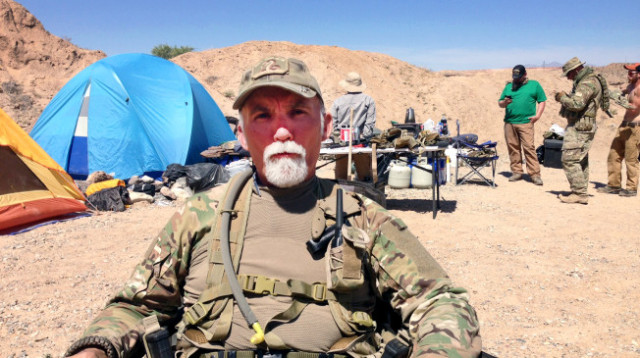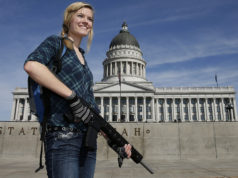
FBI agents have arrested Jerry DeLemus, second amendment activist and co-chair of Veterans for Trump , on Thursday due to his connection with 2014 Bundy Ranch standoff in Nevada.
He’s charged with “conspiracy to commit an offense against the United States, threatening a federal law enforcement officer, attempting to impede or injure a federal law enforcement officer and several firearms charges.”
Susan DeLemus, state representative, wife of Jerry, and fellow Trump supporter, confirmed that he was arrested in the New Hampshire Leader newspaper. Trump announced that he was forming Veterans for Trump in July and named DeLemus among the co-chairs.
(TPM) The standoff in Nevada two years ago came after federal officials said Nevada rancher Cliven Bundy allowed his cattle to graze on federal land for decades without paying grazing fees. Bundy invited hundreds of followers, many of them armed, to his ranch to push back against federal officers who were impounding his cattle.
The event resurfaced in headlines this year when Bundy’s sons, Ammon and Ryan Bundy, organized a standoff of their own at a federal wildlife refuge in rural Oregon. DeLemus traveled to Oregon to visit their occupation and called their cause “peaceful” and “constitutionally just.”
DeLemus told Reuters at the time that he wanted to tell Trump “the whole story” of the Oregon occupation, adding that he expected the story would “arouse” the real estate mogul and inspire him to head West. The standoff lasted for 41 days and resulted in several arrests and the death of one militant in a confrontation with police. Trump never visited the refuge, but did say that he would have acted to end the standoff because “you cannot let people take over federal property.”
The Bundy situation was much more complicated than the media let on, and Brietbart did a fantastic write up on the topic:
“The Bundy Ranch roundup has understandably stirred thin-stretched emotions as the federal government seizes cattle belonging to the Bundy family. The family settled in the late 1800’s and has ranched in the area since. The federal government allowed Nevada ranchers to graze their cattle on federal tracts of land adjacent to their private properties for generations. The federal government later created the Bureau of Land Management (BLM) to administer and “protect” the vast swaths of federal land—including the land the Bundy family’s livelihood was—and still is—dependent upon. The BLM began restricting ranchers’ usage of federal lands to protect various species, and the BLM decided to restrict the Bundy family’s usage of the federal land they historically grazed.
The federal government told the Bundy family that a tortoise existed on the land and therefore the land’s usage for cattle would have to decrease—thus creating a scenario where the Bundy family could make fewer resources. A 20-year legal battle ensued.
There exist a number of elements to the story that inject shades of grey into the dominant media narrative. Perhaps hundreds of Bundy supporters have already shown up to the ranch area to “protect” the family and their land—which is federal land—but federal land such usage was promised to the family in the government’s efforts to get people to settle the West after Mexico ceded the land to the U.S. Court documents—discussed later in this article—reveal that the Bundy family decided at some point that the federal government was illegitimate and that they no longer had to give heed to the federal courts.
The Bundy family patriarch has openly stated his willingness to use force against federal agents if they take his cattle off of the federal lands; the federal agents stand ready to use force against the family or their supporters if they interfere with the cattle removal. Both sides are armed, both sides are frustrated, and the rhetoric and hyperbole surrounding the entire matter has left many onlookers from around the world confused as to what is actually happening.
In the immediate aftermath of the infamous cattle roundup, Cliven Bundy granted a number of high profile media interviews continuing to deny—to the point of absolutely ignoring family history—what the federal courts have twice told him.
“I believe this is a sovereign state of Nevada,” Bundy recently told a Dana Loesch. “…I abide by all of Nevada state laws. But, I don’t recognize the United States Government as even existing.”
Loesch: “So essentially you have a deal already with Nevada and the Bureau of Land Management is essentially trying to revoke or renege that deal?”
Cliven Bundy: “Yeah, it gets back to the ownership of this. Who owns this land? Does the sovereign State of Nevada own this land within their borders? Or does the United States own this land with their borders? If United States owns this land then I guess I’m wrong. But what if this is a sovereign State of Nevada and Clark County, Nevada owns this land? The People of Clark County, Nevada owns this land.”
The answers to Mr. Bundy’s questions have been given—twice.
Perhaps the most unfortunate aspect of this episode–aside from the headline-grabbing details and viral video content—is that it could have served as a strong case study for 21st Century review of the necessity for mass federal land ownership being utilized for private purposes. Between federal budget constraints, political “land grabs” and increasing enforcement costs, perhaps it is time to discuss how the U.S. can offload land tracts to parties in demand through the free market. However, those discussions are difficult to initiate when one does not recognize the sovereignty of their presumed adversary.
Given the fact that this cattle impound took 20 years, two federal lawsuits with appeals and a number of administrative threats before actually occurring—the federal government’s record of enforcement deserves a closer look as well.
The Bundy family can in fact claim to have enjoyed generations of grazing rights on federal land—with an arrangement originating in the 1870s. Adjacent to their personal property, the family was allowed to utilize what was known as the Bunkerville Allotment.
The Bundy family’s battle with the federal government–now playing out in international news coverage—began in 1993 with the listing of a native tortoise incorporated under the Endangered Species Act. As a result, the U.S. Department of Interior’s Bureau of Land Management (BLM) informed grazing permit holders like Bundy that cattle counts would need to be reduced to 150 head. That same year, the Bundy permit was eligible for renewal but was not executed. The permit was later revoked in 1994 by the BLM for nonpayment on the renewal, according to federal court records.
Claiming that the Bundy family continued to graze livestock on their old Bunkerville Allotment without permit, the BLM sought an injunction in federal court to correct the “trespass” in 1998. The court ordered the Bundy family remove all non-permitted livestock by November 30, 1998 or face fines of $200 per head, per day. The family appealed to the 9th Circuit Court—only to be denied in May 1999.
Throughout the period of 2000 to 2011–spanning both Bush and Obama Administrations–the BLM performed a series of investigations with a variety of reconnaissance tactics to track the alleged trespass of cattle owned by the Bundy family. According to court records, federal agents noted increasing herd sizes on the land formerly allotted and adjacent tracts which were never permitted to private parties. Investigators noted that “more than half” of the cattle did not bear any brand but were confirmed to be the property of Bundy “in correspondence,” according to filings.
Federal bureaucrats took great interest in the increased grazing on a tract known as the “New Trespass Lands” adjacent to the old lease once held. Further, Bundy brands were spotted in the neighboring Lake Mead recreational area.
In June 2011, BLM sent a fresh cease and desist order with a renewed threat to impound stray cattle in July 2011. Later in November, the National Park Service (NPS) sent a separate letter regarding alleged trespass on the two new tracts with a 45 day impound threat. In January 2012, the Bundy family told NPS they would work to round up stray cattle ahead of the deadline.
According to court records, the BLM claimed to have surveyed 600 head of cattle on the New Trespass Lands (typically described as a nature preserve by the DOJ) in February 2012. A month later, the figure was officially revised upward to 790, accounting for “recently born” calves.
In April 2012, court records indicate that a final administrative effort was made on the part of the BLM to resolve the alleged trespass on the tracts—including the federal lands traditionally used by the Bundy family and additional federal lands the Bundy family began using without permission on or around 2000. According to testimony, federal agents attempted to broker a deal involving the Clark County Sherriff that would allow cattle to be wrangled and transported to a sales market of the Bundy family’s choosing and allow the family to keep all proceeds. Court filings referenced Cliven Bundy’s assertion that any such action to round up cattle could lead to a “range war.”
Claiming to have exhausted all options, the U.S. Government filed a new civil lawsuit against the family for specific alleged trespass on the New Trespass Lands and the Lake Mead recreational area in May 2012. Court records reference Bundy’s confirmation in deposition that the cattle–branded or not–were indeed his on the tracts. Further, the DOJ detailed the family’s ranching improvements to the off-limits New Trespass Lands to include corrals, water troughs, hay and grazing supplements—such improvements were explicitly prohibited for any party, according to court records. The government repeatedly reminded the court that no grazing permits in the disputed area were ever offered. When asked in deposition what reaction the Bundy family would have should an impoundment occur, Cliven said he’d do “whatever it takes” to include physical force to stop such action.
The U.S. Government claimed that cattle on or near the two off-limits tracts posed “a significant risk to public safety.” Federal agencies claimed to have been in receipt of reports “of vehicle collisions and near collisions” due to the cattle. Bundy directly denied the allegation.
Throughout litigation, the Bundy family defended its actions using similar defense theories from prior litigation—despite the federal court’s rejection of them. The family argued that the United States did not in fact maintain jurisdiction or ownership of the federal lands in question, citing a specific Nevada code NRS 321.596 Legislative Findings. Bundy also challenged the inclusion of the tortoise as an endangered species.
In July 2013, the federal court granted the DOJ’s motion for summary judgment in favor of the U.S. Government. The court reiterated its position that “the public lands of Nevada are the property of the United States because the United States has held title to those public lands since 1848, when Mexico ceded the land to the United States.”
The Nevada federal district court offered a rather blunt summary of its ruling, “In sum, this most recent effort to oppose the United States’ legal process, Bundy has produced no valid law or specific facts raising a genuine issue of fact regarding federal ownership or management of the public lands of Nevada, or that his cattle have not trespassed on the New Trespass Lands.”
In February 2014, the 9th U.S. Circuit Court of Appeals again rejected Bundy’s claims.
No Easy Solutions
Hundreds of the Bundy family neighbors have been pushed out of ranching, a profession and culture the families shared with generations of their ancestors, by the federal government slowly restricting more and more of the usage of federal lands. The Bundy family has held on—but holding on meant ignoring the rule of law, as much as they would argue that the federal government has ignored the rule of law. After years of federal overreach and corruption—especially from federal agencies restricting public lands or effectively taking the value out of privately-held lands to protect tortoises, spotted owls, and ponds a bird might someday land in—many Americans are boiling and looking for an instance to stand against. The Bundy ranch has filled that role for many. Stated concerns over this being a new Waco or Ruby Ridge have come from the family. The federal government clearly views the armed Bundy supporters with concern—as evidenced by reports of government snipers being nearby and the Federal Aviation Administration (FAA) issuing a no-fly zone for three miles surrounding the Bundy ranch.”







this seems a good law reference: https://www.youtube.com/watch?v=T424sWq1SkE